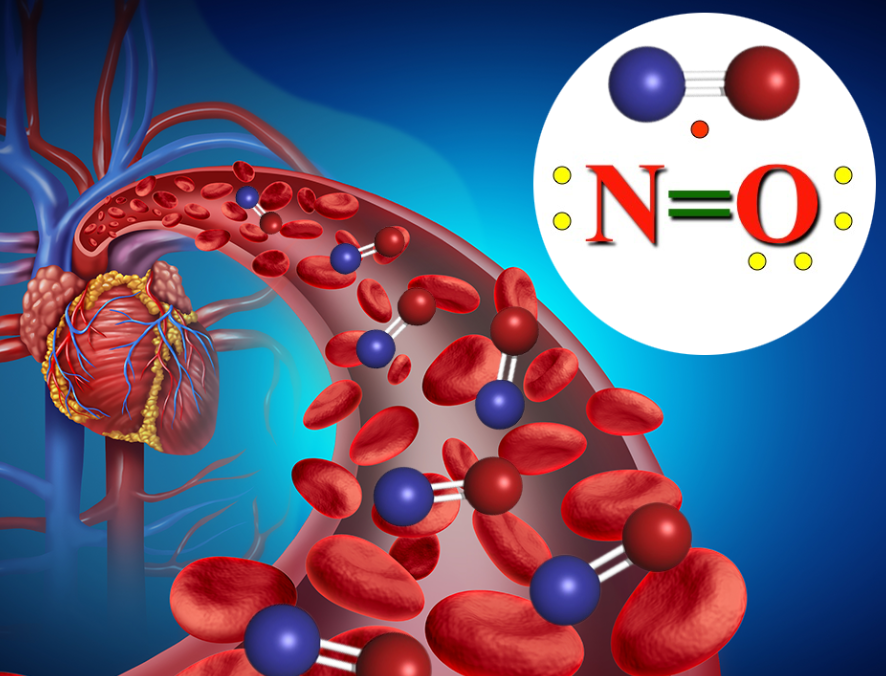Summary
Nitric Oxide (NO) is a signaling molecule that is anti-inflammatory, dilates blood vessels, is anti-oxidant, regulates blood pressure, platelet aggregation, adhesion, and clot formation
- NO deficiency leads to vasoconstriction; increased clotting, inflammation, adhesion, oxidation, and cell proliferation
- Impaired NO generation and signaling contributes substantially to cardiovascular risk
- There are two pathways to make NO. The enzymatic-arginine pathway decreases dramatically with age. The enterosalivary pathway can easily be increased with nitrate-rich foods and supplements. Increasing the enterosalivary pathway can improve the arginine one
- NO deficiency plays a key role in endothelial dysfunction and atherosclerotic plaque formation. Proper NO signaling is critical to proper endothelial and endothelia glycocalyx function
- NO is perhaps the most critical signaling molecule and is involved with correct functioning of multiple systems
- Optimizing NO may be the most important single thing you can do to promote health
Introduction
I apologize in advance for the length and somewhat technical nature of this blog. Nitric oxide (NO) status is perhaps the single most critical factor that is simple to improve, when it comes to the health of the endothelium. To do it, and you, justice, requires a full understanding.
In mammals, including humans, nitric oxide is a critical signaling molecule, without which, dozens of vital metabolic pathways can’t receive their orders to properly function. This discovery by Louis J. Ignore, Robert Furchgott, and Ferid Murad first led to NO being named the “Molecule of the Year” in 1992 (out of the millions of molecules, it received the award). In 1998 their discovery led to the Nobel Prize in Physiology or Medicine. It only works near to it’s site of production, and only exists for 1-2 seconds before being degraded, so a constant source is needed to maintain signaling.
Nitric oxide is a gas, consisting of one molecule of nitrogen, and one of oxygen. It triggers numerous biochemical reactions necessary to maintain optimal health, especially the vascular endothelium, which we shall explore in detail. You produce NO through two very different pathways, which will be fully described, as their understanding is crucial in the all-to-common state of NO deficiency. As we age, less NO is created by the first pathway in the blood vessels and other tissues, but nitrate (NO3 ) containing foods may be converted to NO by the second pathway.
Functions: Physiological, Biochemical & Pathological
Some (by far from all) of the functions of NO include:
- Cardiovascular: Vasodilation, vessel tone regulation, leukocyte adhesion, platelet aggregation, microvascular permeability
- Neurological: Learning, memory, neuronal protection, toxicity, transmission, development; pain response
- Kidneys: filtration, vasodilation, renal endothelial function
- Vision: transmission of photoreceptor vision signals, retina blood flow
- Hormones: Release of many hormones
- Immune: Innate immunity, kills microbes, protects cells from injury
- Antioxidant: neutralizes the potent superoxide free radical O2–
- Respiratory: Dilation of bronchioles, reactivity of lung blood vessels, permeability of alveolar capillary membranes
- Urogenital: Renin secretion, erection, fertilization, spermatogenesis, oogenesis, ovulation
Hopefully you may now begin to appreciate how critical correct levels of NO are to maintain health. Since this article is on the vascular endothelium, we shall focus on this, but keep in mind all the above functions that rely on NO for proper health. Still not convinced that NO is one of the most important modifiable things you can do to help manage a host of health issues? You ask, “Why is NO essential? Here is your answer:
- Controls mitochondrial generation of energy and production of hormones
- Mandatory for sexual function in men (think erectile dysfunction) and in women
- Stem cell mobilization and differentiation
- Regulates inflammatory response
- Free-radical scavenger (anti-oxidant)
- Reduces platelet aggregation (an initial step in plaque production)
- Supports telomerase activity (telomere length is critical for longevity)
- Regulates blood circulation & microcirculation
- Helps regulate blood pressure
- Supports neurotransmitter function
- Activates the GLUT-4 receptor, reducing blood sugar
- Necessary for making new mitochondria.
If you still aren’t convinced, stop reading. If you are, please continue.
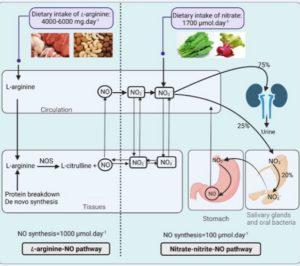
Production Pathways
There are two major ways you can make NO, enzymatic and non-enzymatic.The initial major pathway is the enzymatic L-arginine-NO pathway, shown on the left of the chart below. In this simplified version, NO is made from arginine, which is a semi or conditionally essential amino, meaning that you can produce it (from glutamine and citrulline), but depending on the circumstances, you may not be able to produce enough. This pathway uses the enzyme nitric oxide synthase , which greatly decreases with age (see Nitric oxide and Aging).
The second non-enzymatic pathway is the enterosalivary-Nitrate (NO3) > Nitrite (NO2) > Nitric oxide (NO) pathway. It is by far more interesting. Nitrates are found naturally in the diet. The top ten natural foods to increase NO are3:
- Beets- in 38 adults beetroot juice increased NO by 21% in 45 minutes
- Garlic- increases activity of NOS leading to increased NO, may lower BP
- Lean animal protein- contains CoQ10 which preserves NO
- Dark Chocolate- 30 grams a day raised NO
- Leafy greens- spinach arugula, kale, cabbage are high in nitrates
- Citrus fruit-contain Vit. C which increases bioavailability, increases absorption and is needed to produce NO
- Pomegranate- anti-oxidants preserve NO, increases nitrates in blood, and stimulates NO production
- Nuts and seeds- contain high levels of arginine
- Watermelon is high in citrulline, which is converted to arginine, and thus NO
- Red wine- don’t go crazy here
In the enterosalivary pathway4,5, NO3-rich foods are chewed, swallowed and enter the stomach and duodenum, where the NO3 is absorbed into the general circulation. It is then actively taken up by the salivary glands, highly concentrated by 10-20 times, and released into the saliva. In an area at the back of the tongue, bacteria (commensule facultative anaerobic bacteria, specifically: Rothia mucilaginosa, Haemophilus parainfluenzae, Neisseria flavescens, and Neisseria subflava) reduce NO3 to NO2. The NO2 is re-swallowed, and in the stomach in the presence of stomach acid, is converted to NO.
The great thing is that the body has mechanisms to convert nitrate, nitrite, and nitric oxide back and forth, so once used the NO may be recycled and reused. Since NO lasts only briefly, this is great news. NO is short-lived, so it can’t be easily tested directly, except under research conditions. Fortunately, we can easily test for NO2 , which acts like a surrogate marker for NO. In other words, a simple test may be done, to let you know what your NO levels are. (See below for details).
Nitric Oxide and Aging
If you are reading this, I’m guessing that you are over 30 years old. Why does this matter? Please look at the chart below1. By age 50, production of NO drops significantly from levels produced at 30 years of age, depending on diet and exercise. If you are like the majority of Americans, you may only be creating 10% of the amount you did in your youth. Don’t be discouraged. There is a solution!
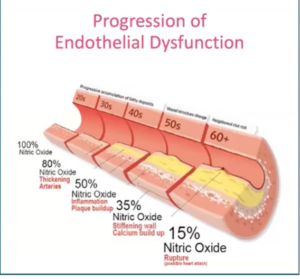
JAmHeartAssoc. 2014 Aug; 3(4)
Note in the diagram below, that consistent with the decline in NO levels is a progression of endothelial function, and vascular disease. This is not a coincidence.
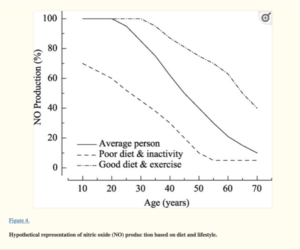
Many factors affect the amount of NO you can produce, including: aging, diet, exercise, medications, pollution and environmental toxins, genetics, epigenetics, and stress. Oxidative stress (free radial damage) cause “uncoupling” of NO production. Earlier in life the “Arginine Pathway” is the primary way to make NO. Normally, when “coupled” NO is created by the proper metabolism of arginine, though the enzyme nitric oxide synthase. With oxidative damage from excess iron or from free radicals, the reaction becomes “uncoupled” and instead the superoxide free radical is made, causing additional tissue damage. The arginine pathway is dependent on adequacy of arginine; a nutrient called tetrahydrobiopterin (BH4) is required by nitric oxide synthase; as is Vitamin C and appropriate amounts of iron; whereas excess iron in it’s highly oxidative state (ferrous or Fe+2) is highly detrimental. The enterosalivary pathway needs adequate dietary nitrate, correct oral bacteria, and stomach acid to create NO.
On the other hand, producing NO through the second pathway will have a beneficial effect on recouping NO production through the arginine pathway and recouple mitochondrial production of energy through the electron transport chain.
NADPH oxidase (NOX) is an enzyme that catalyses the reaction that creates the superoxide free radical. It is found mainly in white blood cells (WBC) and in the vascular endothelial lining. In WBC, creating the superoxide free radical aids in killing bacteria and viruses. Over-activation in blood vessels causes damage, leading to cardiovascular disease. Many things activate NOX. A short list includes: inflammatory cytokines/interleukins, chronic infections, mold, homocysteine, smoking, pollution, glutamate, oxalates, and histamine. Perhaps most important for our purposes when NOX creates more free radicals, it activates a pathway in the kidney called RAAS, causing blood pressure to increase.
Just when you thought it was safe to go back in the water- things get worse! Underproduction of NO caused by uncoupling and overproduction of free radicals caused by activated NOX, leads to what has been termed NADPH steal2. The quantity of NOX is limited. When activated, there is less available for it’s intended purposes to support liver phase 1 detoxification processes, recycling of critical antioxidants (glutathione), and production of NO, creating a Catch-22 or vicious cycle. But there is hope!
Things that Decrease Nitric Oxide
As you may expect, the list of things that decrease NO, and therefore increase your risk for developing virtually any and all of today’s chronic degenerative diseases, is essentially the same list that causes those conditions in the first place, including:
- Age
- Physical inactivity
- Standard, pro-inflammatory American diet
- Medications- antibiotics, antidepressants, birth control pills, NSAID’s, PPI’s
- Low stomach acid
- Periodontal disease
- Fluoride, whitening toothpaste, anti-bacterial mouthwash
- Environmental toxins- herbicides (Roundup/Glyphosphate), insecticides, industrial chemicals, heavy metals, other pollutants
- Stress
- Electromagnetic fields (EMF’s)
- Poor sleep
Things that Increase Nitric Oxide
Fortunately, there are a number of things you can do to benefit your NO levels, including:
- Refer to the list of foods above
- Improve the rest of your diet to reduce trans-fatty acids (fried foods), omega-6 fatty acids (vegetable oils/margarine), junk food, and sugar/fructose/simple carbohydrates
- Consider a Paleo or low-fat (20-25% of calories) Keto lifestyle
- With a doctor’s approval, stop taking PPI’s (Proton Pump Inhibitor’s)
- Start exercising
- Stop using a mouthwash that kills bacteria, fluoride and teeth whitening toothpaste, and replace with proper oral hygiene of flossing, water pick, brushing three times daily, and oil pulling with coconut oil
- Do your best to reduce exposure to toxins, pollutants, heavy metals, and EMF’s
- Do your best to reduce stress and improve sleep
- The easiest thing to do is to take a supplement that will increase NO. This shouldn’t be a substitute for any of the above, but in addition to
Types of Nitric Oxide
The focus of this blog is on NO as it relates to the vascular endothelium. It would be remiss not to point out that there are actually different nitric oxide enzymes, acting to produce NO in different tissues, each creating different signals and responses. In the nervous system there is neuronal NOS, abbreviated nNOS. The immune system has inducible NOS (iNOS). We are concentrating on endothelial NOS (eNOS), which produces NO in the vascular system. Appropriate levels of NO in the nervous and immune systems are necessary. Chronic elevations due to many of the above discussed factors, is detrimental as chronic inflammation and oxidative damage occur, further compounding nervous system disorders and over-activating the immune system. For our purposes, it is an inappropriate immune response that eventually leads to plaque formation.
Measuring Nitric Oxide
As previously stated, NO lasts only momentarily before being converted to nitrite, which lives 20-45 minutes before being converted to nitrate, which lives 4-8 hours6. Fortunately, it has been well-established that NO2 acts as a surrogate marker for NO, and is easy to measure7. Therefore an indirect way to measure NO is through salivary test strips, which actually measure NO2. Test strips are available under $20 online. Our office offers free testing upon request. This is a screening test, not a definitive one.
A second method is a common lab test for ADMA (Asymmetric DiMethylArginine). ADMA blocks conversion of arginine to NO. The higher the ADMA, the lower the NO.
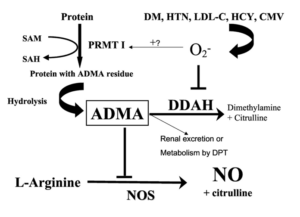
Nitric Oxide and the Endothelium
Hopefully, you now know why it was important to understand the basics of nitric oxide prior to a discussion of it’s relationship to the vascular endothelium. Space prohibits a full thesis, as there are hundreds of research papers published annually on NO and the endothelium. Here are some highlights.
- NO and hypertension: 12 people with hypertension took Vascanox (a natural product shown to increase NO), two capsules/day, for 4 weeks. At the end of the trial, systolic blood pressure dropped 11 points, and diastolic 10 points on average.Salivary NO2 testing showed dramatic increases from baseline throughout the trial6.
- Aging8 is associated with impairment of NO production and utilization, with negative effects on cardiovascular disease. Increased platelet adhesion, low Vitamin D, elevated ADMA, diabetes, being female, and poor kidney function were related
- All known cardiovascular risk factors9 increase inflammation, and lead to endothelial glycocalyx dysfunction and degradation, decreased NO production and release; causing “leaky blood vessels”. This causes oxidative stress and immune activation, leading to foam cell formation and end organ damage
- Vascular disease10 is a systemic disease involving arteries, arterioles, and capillaries; leading to stroke, TIA’s, vascular dementia, aortic aneurysm, kidney disease, hypertension, ischemia and hypoxia (low oxygen levels), angina, heart attack, peripheral artery disease, and much more. The keys to maintaining optimal blood flow are a healthy glycocalyx and endothelium and normal blood pressure
- In a mouse study11, dietary nitrate significantly reduced endothelial dysfunction and plaque formation. NADPH activity and oxidative stress were also decreased.
- High blood pressure is a major risk factor for cognitive decline, as it reduces blood flow to the brain. The brain normally produces 20 times more NO than the entire rest of the blood vessels in the body (all 60,000 miles of them). NO regulates the microcirculation in the brain. Low oxygen (hypoxia) increases brain degeneration. Low NO reduces neuroplasticity (formation of new nerve connections), reduces production of neurotransmitters, creation of new brain cells, and decreases mitochondrial energy production. A huge study12 showed that people who took sildenafil (Viagra) which works by increasing NO production, had a 69% lower risk of developing Alzheimer’s. NO is required to release oxygen from blood, without it oxygen delivery is impaired. With hypoxia, decreased energy production uncouples mitochondria, and increases superoxide free-radical production, creating more damage13.
Conclusions
There may no more single critical metabolic pathway in the body than maintaining optimal NO levels. We have only touched on a few of it’s functions. Future blogs will delve into the applications of NO supplementation as it relates to blood sugar, gastrointestinal issues, periodontitis, kidney function, mitochondrial energy production, immune dysregulation, cognition, hormone dysfunction, and more. Stay tuned.
We offer free salivary strip testing for NO deficiency. For our existing patients, the ADMA blood test is also available. Cost is $18-60.
References
- https://www.ncbi.nlm.nih.gov/pmc/articles/PMC3390088/#
- https://www.nutrigeneticresearch.org/research
- https://www.healthline.com/nutrition/nitric-oxide-foods
- https://gut.bmj.com/content/gutjnl/40/2/211.full.pdf
- https://academic.oup.com/cardiovascres/article/89/3/525/324945
- https://www.cureus.com/articles/187937-effects-of-s-allylcysteine-rich-garlic-extract-and-dietary-inorganic-nitrate-formula-on-blood-pressure-and-salivary-nitric-oxide-an-open-label-clinical-trial-among-hypertensive-subjects#!/
- https://clinicalnutritionespen.com/article/S2405-4577(20)30176-5/fulltext
- https://www.ahajournals.org/doi/10.1161/JAHA.114.000973
- https://pubmed.ncbi.nlm.nih.gov/11877368/
- https://pubmed.ncbi.nlm.nih.gov/31420554/
- https://pubmed.ncbi.nlm.nih.gov/32524996/
- https://www.medicalnewstoday.com/articles/could-viagra-reduce-alzheimers-risk
https://www.pnas.org/doi/10.1073/pnas.17239949
About the Author: Dr. Douglas L. Weed.
Dr. Weed practices Functional Nutrition, Chiropractic care, and offers weight loss solutions in Napa, CA at Heun Chiropractic, Inc. He has a doctorate in Chiropractic care and he has received certifications in physical rehabilitation and as a Qualified Medical Examiner. With a post-graduate certification in Functional Medicine, focusing on functional endocrinology, digestive disorders and Peripheral Neuropathy, he is committed to lifelong education and helping patience transform their health.

